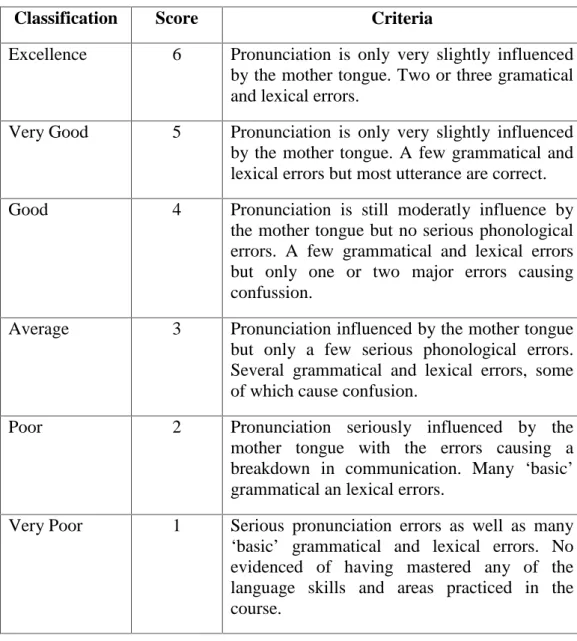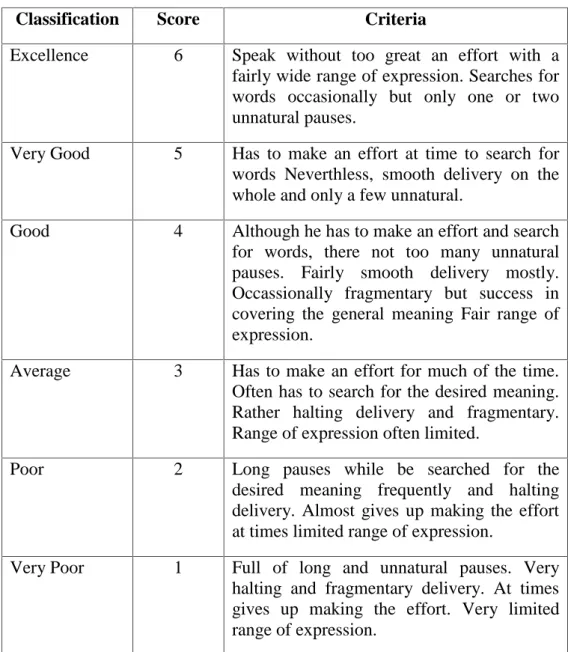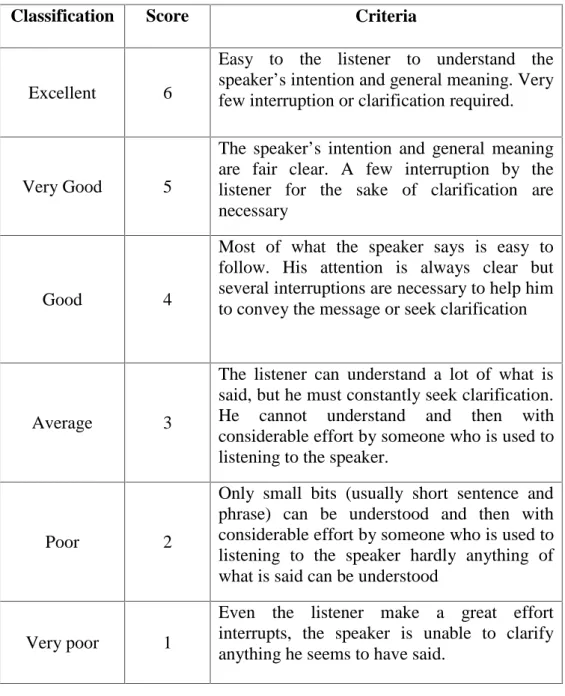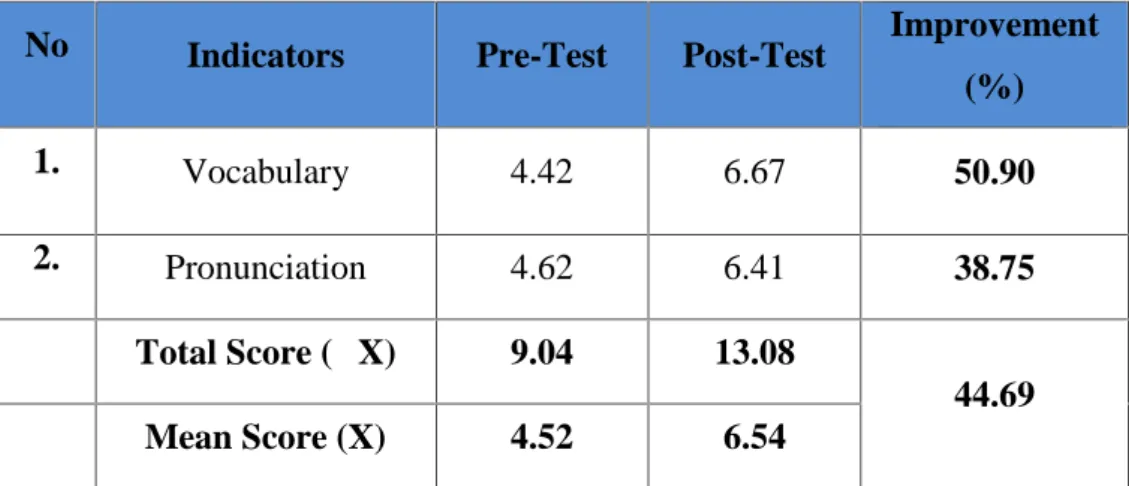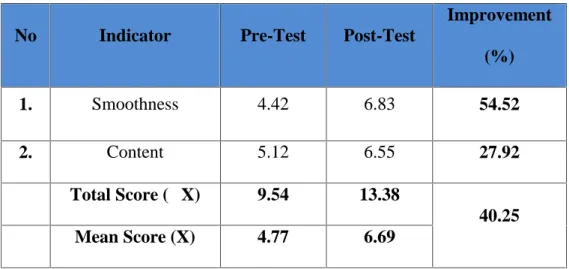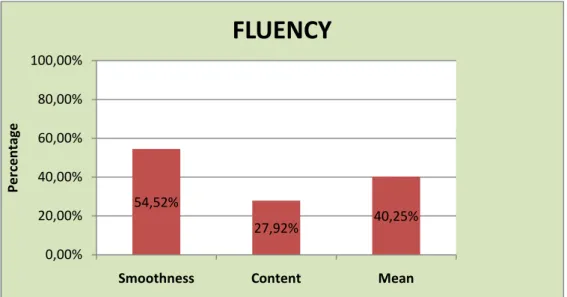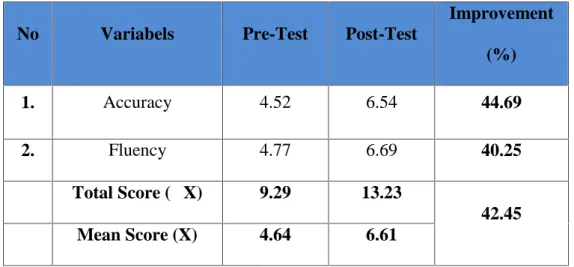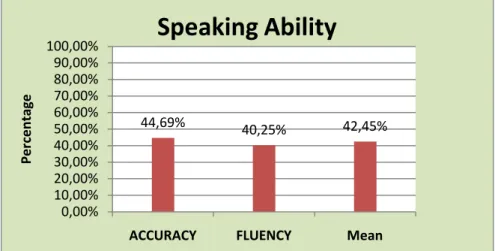INTRODUCTION
Background
Language plays a major role in the intellectual, social and emotional development of students and is the key to successful study of the entire subject. In the curriculum, speaking is one of the fundamental competencies that students should master." Within each skill are some language forms, namely grammar, vocabulary and pronunciation.
Out of four main language skills above, the writer tends to expand one of the main language skills which is speaking. Furthermore, learners are not exposed to the cultures of the native English speakers." They got a lot of speaking material from their teacher, but after they finish, many of them still find it so difficult to speak. It is impossible for the students to improve their speaking ability if they rarely use it in every occasion until it becomes a habit.
As a result, only highly motivated students always benefit from the points, and students do not know their participation progress.
Problem Statement
Objective of the Research
Significance of the Research
Scope of the Research
There were significant differences between students' speaking abilities after using the participation points system. To clearly see the improvement in students' speaking ability in terms of accuracy and fluency, follow the figure below;. We can conclude that the participation points system is effective for improving students' speaking skills.
Therefore, Participation Point System is effective in improving the students' speaking ability in terms of accuracy. It can be concluded that Participation Point System is effective in improving the students' speaking ability in terms of fluency. ASSESSMENT SCORE OF THE STUDENTS' SPEAKING ABILITY (FINAL SCORE) IN SPEAKING IN PRE-TEST AND POST-TEST AT THE SECOND CLASS.
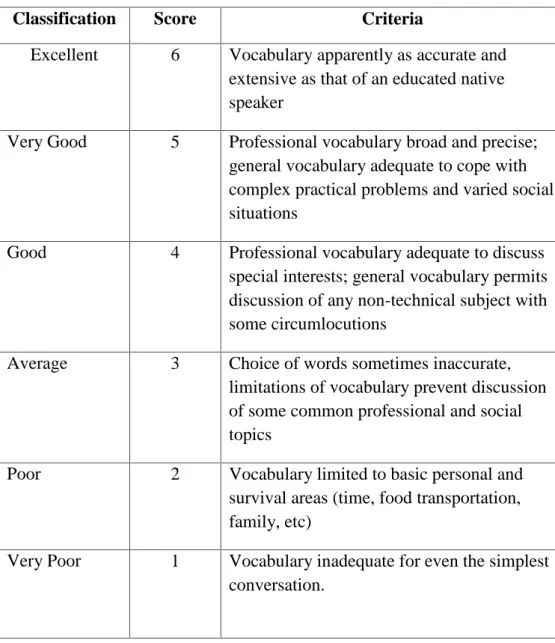
REVIEW OF RELATED LITERATURE
The Concept of Participation Point System Method
- How to Apply Participation Point System?
- PPS Method in Improving Students’ Speaking Ability
- The Advantages of Participation Point System Method
The Concept of Speaking
- Types of Speaking
- Practical Technique of Speaking
- Elements of Speaking
- Assessing Speaking Ability
To clearly see the improvement in students' accuracy in vocabulary and pronunciation, follow the figure below;.
RESEARCH METHOD
Research Design
The research design used the pretest-posttest design with one group doing the pretest, treatment, and posttest. In the pre-test, the students were given the pre-test before the treatment to know the prior knowledge and to find out the students' speaking ability before teaching through the Participation Point System. Here more merbelas were distributed for their participation.
At the second meeting, the teacher presented material on expressions of agreement and disagreement and still the same first meeting activity. In the third meeting, the teacher explained about invitation and still the same activity in the previous meeting. In the fourth meeting, the teacher explained the retelling text and the meeting activity was different from the previous meeting.
After the treatment, a post-test was administered to discover the students.
Research Variables and Indicators
Pronunciation; knowing the manner of the spoken language or understanding the rules of pronunciation correctly and without major influences of the mother tongue. Dictionary; language development in speaking knowing the correct words/appropriate words in the context constraint. Tenderness; the ability to speak English with a good range of expression easily and easily (at normal speed and without difficulty).
Contents; the ability to speak English with a good range, the meaning is easy to listen and understand.
Hypothesis
Population and Sample
Research Instrument
Procedures of Collecting Data
There is no proof of mastery of any of the language skills and areas practiced in the course. Very good 5 Must make timed effort to look up words Anyway, smooth delivery overall and only a few unnatural ones. His attention is always clear, but some interruptions are necessary to help him get the message across or to ask for clarification.
The listener can understand much of what is said, but must constantly seek clarification. He cannot understand, and then with considerable effort, someone who is used to listening to the speaker. Only small fragments (usually a short sentence and a phrase) can be understood, and then someone who is used to listening to the speaker can hardly understand anything that is said with great effort.
Even the listener makes a great effort to interrupt, the speaker is unable to clarify anything he seems to have said.
Technique of the Data
Improving students' speaking accuracy The graphic above shows students' improvement in accuracy in terms of vocabulary and pronunciation. Improving students' speaking fluency The graphic above shows students' improvement in fluency handling smoothness and content. The mean of students' posttest accuracy is higher than the mean score of students' pretest.
The student's speaking proficiency score on the posttest is higher than the average score on the student's pretest. Before the treatment is given, the speaking skills of the students in both classes are assessed as poor. The participation points system is a good way to improve the speaking skills of the eighth grade students of SMPN 1 Majauleng.
FINDINGS AND DISCUSSIONS
Findings
- The Improvement of the Students’ Speaking Ability in
- The Improvement of the Students’ Speaking Ability in
- The Improvements of the Students’ Speaking Ability
- The Significance of the Students’ Speaking Ability
The findings of the study provide a clear answer to the problem statements as the feasible objective of the study, which aims to find out the improvement of students' speaking skills by using the participation points system in the eighth grade of SMPN 1 Majauleng. It is classified as a poor category, but after using the Participation Point System in treatment, the average post-test score becomes 6.54. The improvement of students' vocabulary is 50.90%, the improvement of students' pronunciation is 38.75%, and the improvement of both is 44.69%.
Based on the above percentages, there are significant improvements among students through the use of the Participation Point System in teaching English language accuracy. It is classified as a poor category, but after using the Participation Point System in treatment, the average post-test score becomes 6.69. To clearly see the improvement of the students, fluency and content, the image below;.
The students' improvement in fluency is 54.52%, the students' improvement in pronunciation is 27.92%, and the improvement of both is 40.25%. Based on the percentages above, there are significant student improvements using the Participation Point System to teach English speaking fluency. To find the students' improvement in speaking, the researcher gave a test which is given twice to the students.
The data in the table above show two variables of speaking ability as a result of students' pre- and post-test calculations using the Participation Point system. According to the above percentages, a significant progress of students using the participation point system in teaching English is noticeable. To know the level of significance of the pre-test and post-test, the researcher uses the hypothesis-based t-test analysis.
That t-test value is greater than t-table (T-Test> T-Table), the final result shows that t-test value for the final score of students' speaking ability is (11.37 > 2.018). This means that there is a significant difference between the students' speaking ability before and after using Participation Point System.
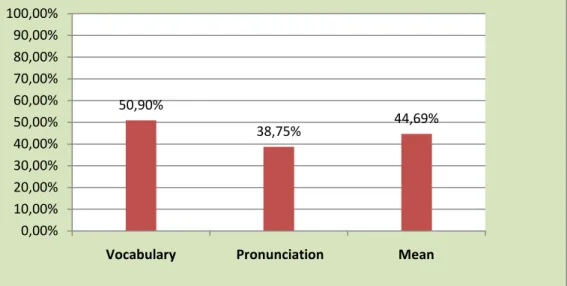
Discussions
- Students’ Improvement in Accuracy
- Students’ Improvement in Fluency
- The Implementation of Participation Point System
According to the above research results in applying the Participation Point System in the classroom, the data is collected through the test, as explained in the previous findings section. This shows that the students' speaking skills in terms of fluency have improved significantly. Based on the findings in the previous chapter, the researcher draws the conclusion that teaching English through the Participation Point System is important to increase students' speaking skills. Using the Participation Point System in speaking is effective in increasing students' accuracy when it comes to vocabulary and pronunciation in the eighth grade of SMPN 1 Majauleng.
The use of the Participation Point System in speaking is effective in increasing students' speaking skills, which ensures smoothness and content in the eighth grade of SMPN 1 Majauleng. The teacher should make a lesson motivated and interesting so that students can enjoy studying in class. 2012. Improving Students' Speaking Skills through Role Playing Technique during the First Year of SMANegeri 14 Makassar.
2002. Improving the students' speaking skill using Meteor Garden Story as a teaching device using communicative approach. Ask the students to do a communicative activity about the material and give them marks for their participation. Check the students' homework and revision of the previous material B. Retell text is a text that retells events or experiences in the past.
CONCLUSION AND SUGGESTIONS
Conclusion
Based on the findings and discussion of the study, it can be concluded that the use of participation points system in speaking is effective in increasing the speaking performance of the eighth grade students of the SMPN 1 Majauleng academic year 2014/2015.
Suggestion
Guru menginformasikan kepada siswa (klasik) bahwa yang akan dipelajari adalah materi tentang meminta dan memberi pendapat. Guru mengawasi dan memberi nilai terhadap setiap partisipasi siswa dan siapa yang aktif dalam diskusi. Siswa dapat menggunakan tindak tutur dan menanggapi pernyataan setuju dan tidak setuju serta ucapan selamat.
Guru menginformasikan kepada siswa (secara klasikal) bahwa yang akan dipelajari adalah materi tentang pernyataan setuju dan tidak setuju. 2. Siswa dapat menggunakan tindak tutur tanya jawab tentang mengundang, menerima dan menolak ajakan. Guru memeriksa pekerjaan rumah dan siswa, memberikan poin kepada setiap siswa yang mengerjakannya dan mendiskusikan pelajaran sebelumnya.
Guru menginformasikan kepada siswa (klasik) bahwa yang akan dipelajari adalah materi tentang ajakan, penerimaan dan penolakan ajakan. Guru meminta siswa memberikan contoh materi terkait dan memberi nilai kepada siswa yang bertindak. Guru mengawasi dan memberi nilai kepada setiap siswa yang berpartisipasi dan aktif dalam diskusi.
Siswa dapat mengajukan pertanyaan secara lisan dan menanggapi berbagai informasi dalam teks narasi pendek. Guru memberitahukan kepada siswa (klasik) bahwa materi bertanya dan memberikan pendapat akan dipelajari. Guru mendampingi siswa dalam menganalisis teks narasi dan menilai siswa yang aktif dan tenang.
